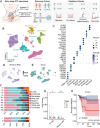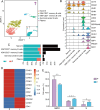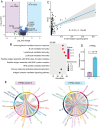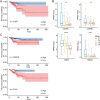Single-cell transcriptomics analysis reveals that the tumor-infiltrating B cells determine the indolent fate of papillary thyroid carcinoma
- PMID: 40069827
- PMCID: PMC11895268
- DOI: 10.1186/s13046-025-03341-7
Single-cell transcriptomics analysis reveals that the tumor-infiltrating B cells determine the indolent fate of papillary thyroid carcinoma
Abstract
Objective: Active surveillance (AS) offers a viable alternative to surgical intervention for the management of indolent papillary thyroid carcinoma (PTC), helping to minimize the incidence of unnecessary treatment. However, the broader adoption of AS is hindered by the need for more reliable diagnostic markers. This study aimed to identify the differences between indolent and progressive PTC and find new targets for biomarker development and therapeutic strategies.
Methods: We used single-cell RNA sequencing (scRNA-seq) to analyze cellular differences in 10 early-stage PTC tumors. Findings were validated in an additional 25 tumors using cell co-culture, migration assays, immunofluorescence staining, flow cytometry, and analysis of data from The Cancer Genome Atlas (TCGA).
Results: Tumor-infiltrating B cells (TIL-B), particularly germinal center B cells (GC-B), were more abundant in indolent PTC. These cells suppressed thyroid cell proliferation in both indolent and progressive cases, though indolent PTC had a higher capacity to recruit peripheral B cells. In indolent cases, TIL-B cells showed increased proliferation and formed clusters within tertiary lymphoid structures (TLS). PTPRC-CD22 interactions were identified as potential drivers of TIL-B cell proliferation. Markers linked to GC-B cells, such as LMO2, were highlighted as potential diagnostic and prognostic indicators for indolent PTC.
Conclusion: This study provides insights into the cellular landscape of early-stage PTC, revealing distinct tumor and immune microenvironment features in indolent and progressive cases. These findings advance the understanding of indolent PTC biology and support the development of reliable diagnostic and prognostic biomarkers.
Keywords: Germinal center B; Indolent; Papillary thyroid carcinoma; Tumor-infiltrating B.
© 2025. The Author(s).
Conflict of interest statement
Declarations. Ethics approval and consent to participate: This study was approved by the ethics committee of First Affiliated Hospital of Kunming Medical University. Informed consent was obtained from all the subjects at the time of enrollment. Clinical trial number: not applicable. Consent for publication: All authors contributed significantly to the conception, design, execution, and interpretation of the research. They reviewed and approved the manuscript and agreed to be listed as co-authors. Competing interests: The authors declare no competing interests.
Figures






References
-
- Siegel RL, Giaquinto AN, Jemal A. Cancer statistics, 2024. CA Cancer J Clin. 2024;74(1):12–49. - PubMed
-
- Li M, Dal Maso L, Vaccarella S. Global trends in thyroid cancer incidence and the impact of overdiagnosis. Lancet Diabetes Endocrinol. 2020;8(6):468–70. - PubMed
-
- Li M, Zheng R, Dal Maso L, Zhang S, Wei W, Vaccarella S. Mapping overdiagnosis of thyroid cancer in China. Lancet Diabetes Endocrinol. 2021;9(6):330–2. - PubMed
-
- Oh HS, Ha J, Kim HI, Kim TH, Kim WG, Lim DJ, Kim TY, Kim SW, Kim WB, Shong YK, Chung JH, Baek JH. Active Surveillance of Low-Risk Papillary Thyroid Microcarcinoma: A Multi-Center Cohort Study in Korea. Thyroid. 2018;28(12):1587–94. - PubMed
MeSH terms
Substances
LinkOut - more resources
Full Text Sources
Medical
Research Materials
Miscellaneous

